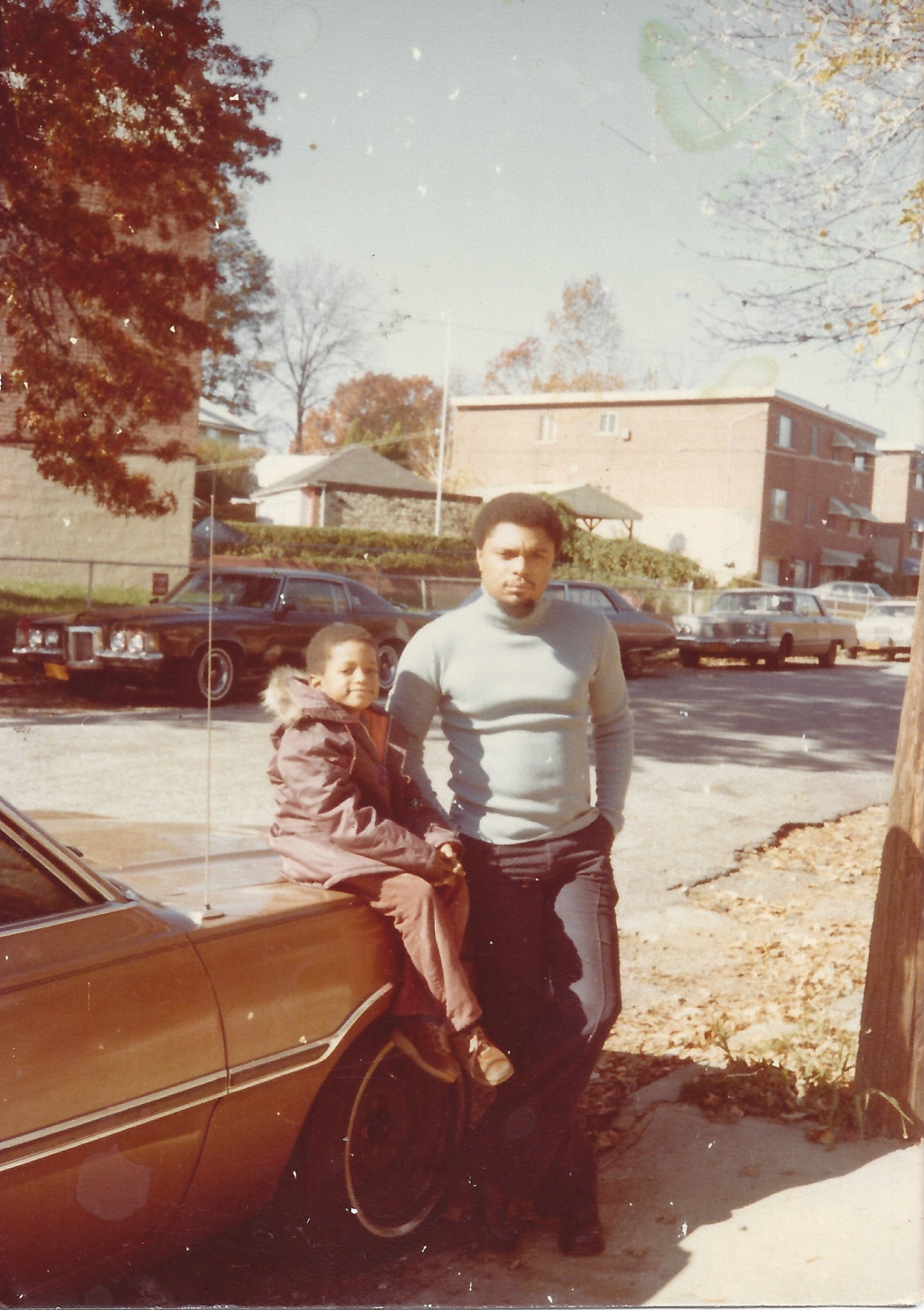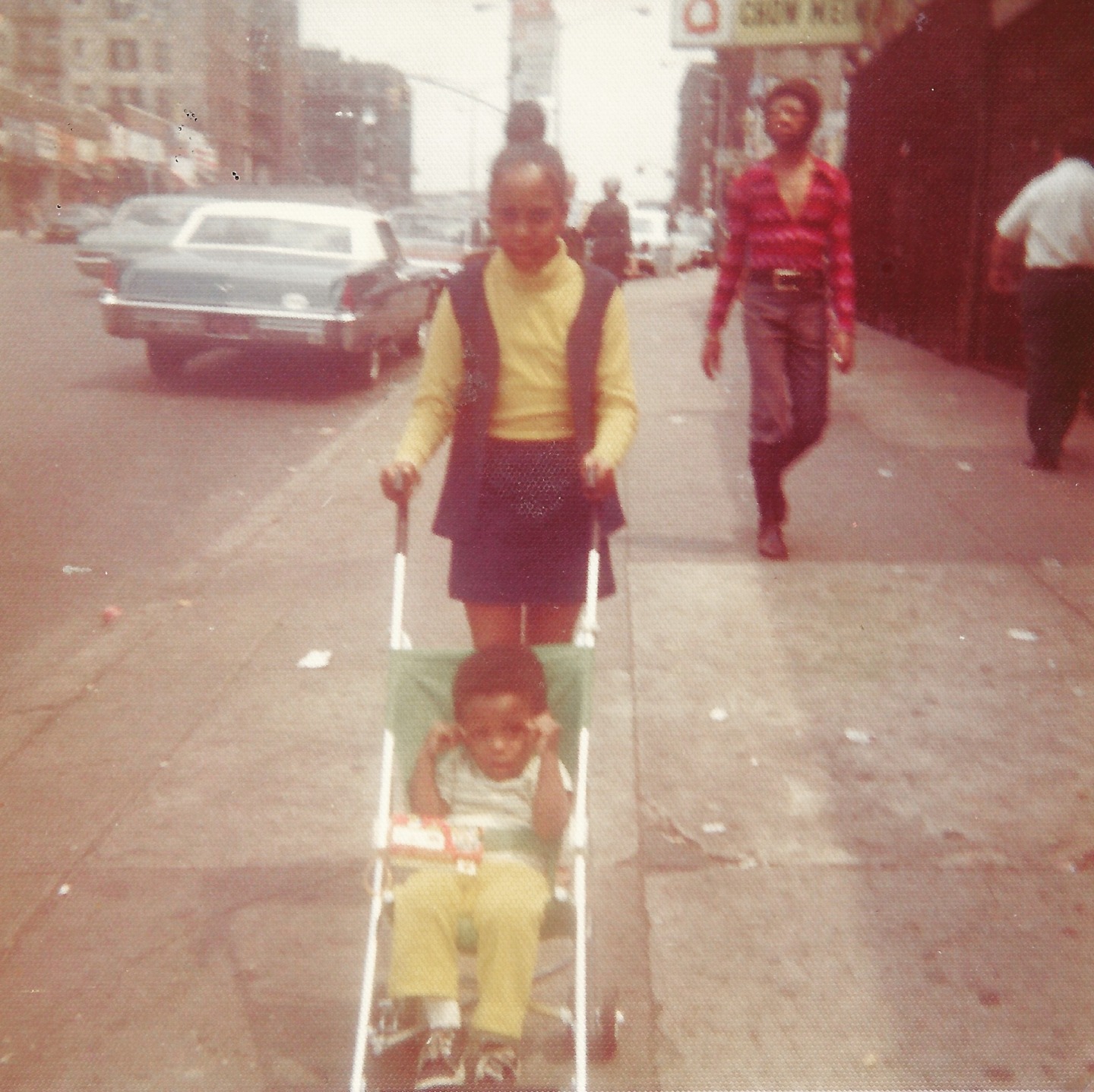 The author with his father on Bruner Avenue in the Northeast Bronx.
The author with his father on Bruner Avenue in the Northeast Bronx.
The third episode of The Get Down — the Baz Luhrmann-directed series set to debut on Netflix on August 12 — details the blackout of 1977 from a vantage I share as a kid from the Bronx.
The July 13 blackout struck as I returned from the borough’s Orchard Beach with my family, showering off sand at my grandma’s house off 233rd Street. I still remember sitting on my grandparents’ porch at 4006 Bruner Avenue and surveying the neighborhood, the candles and flashlights, the rumors of bricks through windows and so-called “Christmas in the ghetto” looting. Unlike The Get Down’s Shaolin Fantastic (played by Shameik Moore) lifting equipment from Les Inferno disco, I was far too young for any midnight marauding. But I still felt jealous of jacking reports televised on the news the next day, dreaming of all the Mego superhero action figures at Toys “R” Us that went untouched.
The Get Down feels like a private fever dream, as if Luhrmann reached right into my subconscious to shape his new show about the formative days of hip-hop. I will always look for myself in the background of New York City streets shot by photographer Jamel Shabazz from the 1970s and ’80s, wondering if I am there, spraying water on passing cars from open fire hydrants, flipping on dirty mattresses, or racing past graffitied abandoned buildings pumping water pistols with my cousins. The Get Down mythologizes the era of my earliest childhood memories with a finesse and attention to detail that, personally, makes it feel like more than just a great series.
I was born in 1970, raised in the Mount Eden section of the South Bronx — 38 Marcy Place — until my parents became one of the first families to move to Co-op City in the northeast Bronx in 1974.
I came of age eight miles from The Sparkle at 1590 Jerome Avenue where Grand Wizzard Theodore cut up Thin Lizzy’s “Johnny the Fox Meets Jimmy the Weed,” inventing the scratch technique; three miles from the Big 3 Barbershop where my uncle’s homeboy cut hair with his pops (the shop’s owner) and Slick Rick would come in for an occasional fade; two miles from where Slick Rick actually lived on Baychester Avenue; six miles from the hospital Louis Farrakhan was born in; five miles from where James Baldwin toiled away at the DeWitt Clinton High School magazine, The Magpie; five miles from the Mount Saint Michael’s Academy that a young Sean Combs attended; buildings away from where Kurtis Blow, Queen Latifah, Big Tigger, and Jarobi White all lived in Co-op City; and directly across from the tenement building of Born Unique Allah, one of the Fresh 3 MCs who recorded “Fresh.”
The world at large began its relationship with hip-hop in 1979, with the September release of “Rapper’s Delight.” My own relationship with hip-hop began a bit earlier, a melting Italian ice dripping down my fingers as the late Kool DJ AJ spun records in St. Mary’s Park during the summer of 1978. The sounds of songs like “Take Me to the Mardi Gras” by Bob James and “Apache” by the Incredible Bongo Band seemed deafening even across the street from the ninth-floor window of 550 Cauldwell Avenue, my grandma’s building at the St. Mary’s Park Houses.
 The author with his aunt Barbara on E. 170th Street in the South Bronx.
The author with his aunt Barbara on E. 170th Street in the South Bronx.
When my uncle Craig — six years my senior — went downstairs to shoot skellies or visit homeboys with new vinyl like the Saturday Night Fever soundtrack, my grandmother often sent me along. So it was that ’78 summer afternoon when my curiosity about the commotion in St. Mary’s Park collided with Craig’s social plans to meet with his crew. Naturally, I wanted to return upstairs five minutes later. AJ — immortalized by Kurtis Blow six years later on “AJ Scratch”— had skills, but not enough to maintain the attention of a 7-year-old weaned on Marvel Comics, Bruce Lee, and Courageous Cat and Minute Mouse.
“How, in a time when things were so difficult, did these young kids come up with so much creativity? A creativity that would go on to transform the world?” Luhrmann asked in late July at the Universal Hip-Hop Museum on Brook Avenue. That Bronx screening of The Get Down was filled with people like Spike Lee and hip-hop pioneers Coke La Rock and Grandmaster Caz. “I kept trying to find out the answer to the question. And it brought me to meet people like Grandmaster Flash, Kool Herc and so many people in this room. What I sort of wanted to do was be the curator of that story, and to help that story be told.”
Though the show opens in the late 1970s, South Bronx gangs and their flyin’ cut sleeves were everywhere in the early ’70s. The Black Spades, the Supreme Bachelors, the Black Pearls, on and on. A famous Hoe Avenue peace meeting called a truce to all that warfare back in 1971; I don’t remember any gang violence. But sometime before the birth of these gangs, before my own birth even, both sides of my family paved inroads into the Bronx.
My parents met as high school sweethearts in the 1960s. My father’s grandparents relocated north from Georgia in the 1940s. My great-grandpa’s sister married a reverend who owned a house at 1352 Findlay Avenue in the Claremont section of the South Bronx; my great-grandparents moved upstairs in 1969. Come 1978, my great-grandparents relocated again to 443 St. Ann’s Avenue, in the Mott Haven neighborhood where Grandmaster Flash used to spin. My aunt Juanda hit up Flash’s park jams at the nearby Moore Houses when she could get away with it.
My mother’s parents were raised in Virginia and Georgia; they migrated to Harlem in their teens and raised my mother there before mortgaging an attached row house in the northern Baychester section of the Bronx in 1965. Most of the times I climbed into the backseat of my parents’ Mercury Comet as a boy, tuned into DJ Frankie Crocker, we were on our way to somewhere else within the borough, visiting relatives.
Could my 7-year-old mind consider subway trains bombed with graffiti anything other than the natural state of things?
To hear the media tell it, no finer example of an inner-city wasteland existed on the national map in the mid-’70s. While cousins pushed me on playground swings in Claremont Park during sunlit days, Johnny Carson targeted my grandparents’ neighborhood as the butt of jokes on The Tonight Show way past my bedtime. I recall commercials for Fort Apache, The Bronx, and The Warriors (the campy classic featuring a Brooklyn gang’s escape from The Bronx), Hollywood films that reinforced the popular notion of the area as barren, devastated and dangerous.
As President Gerald Ford refused economic aid to the city — the Daily News headlined “Ford to City: Drop Dead” — and sportscaster Howard Cosell droned on about an inflamed South Bronx school building during a Yankees game, could my 7-year-old mind consider subway trains bombed with graffiti anything other than the natural state of things?
Televised newscasts and Daily News headlines during the blackout summer of 1977 recounted the murderous mission of the .44 Caliber Killer, the Son of Sam. Yonkers night stalker David Berkowitz — a one-time Co-op City resident — terrorized the Bronx for a full year, claiming 15 casualties before his August 10 arrest. The most I ever cared about baseball stems from that season’s World Series (the New York Yankees vs. the Los Angeles Dodgers) and Reggie Jackson’s historic three home runs securing the pennant for the Bronx Bombers.
“So you know that rock?” Baz Luhrmann asked me last month, referencing the huge slab of slate Shaolin Fantastic slides down and spray paints in St. Mary’s Park near the end of episode one. Yes, Baz. That rock has got to be full of psychic imprints from my childhood self, when I toyed around with Micronauts and Space: 1999 spaceships. Does The Get Down properly reflect my youth? Is it a true and accurate depiction of that time? I’d say the series does as good of a job romanticizing the period as I do having grown up there.
Grandmaster Flash, an advisor on The Get Down, introduced Luhrmann at the Bronx screening. In front of a rapt audience, he remarked of those early, organic hip-hop years: “We now have a visual place in history. Because it’s something that we didn’t do, Caz: nobody had a camera. Nobody filmed this. Shit! So now, we have visual representation here. We need the world to know about the Bronx. We matter, baby. The Bronx matters.”